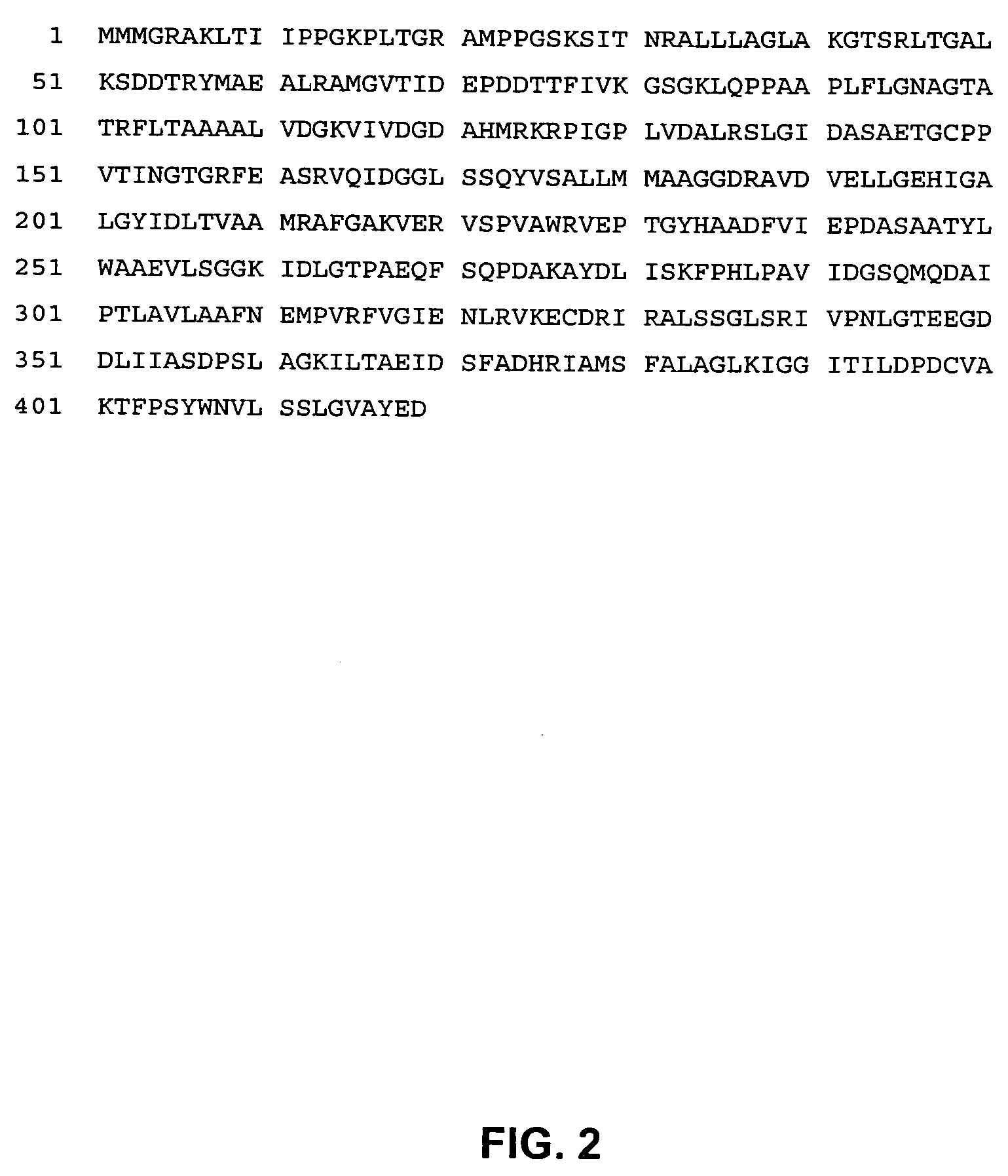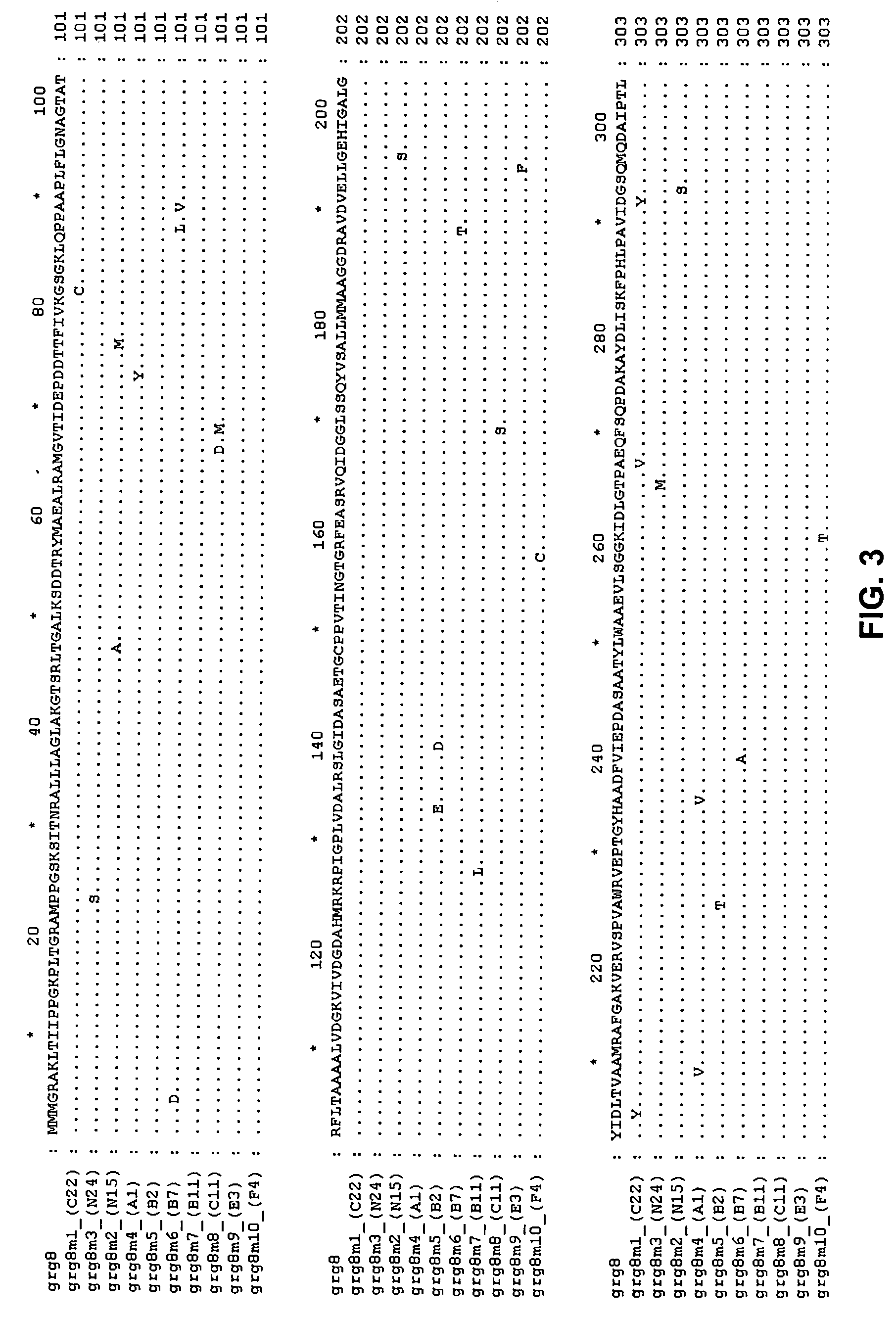Genes conferring herbicide resistance
a technology of herbicide resistance and gene, applied in the field of gene conferring herbicide resistance, can solve the problems of not only to kill plant cells, but also to toxic to bacterial cells,
- Summary
- Abstract
- Description
- Claims
- Application Information
AI Technical Summary
Benefits of technology
Problems solved by technology
Method used
Image
Examples
example 1
Isolation of ATX4145
[0072] ATX4145 was isolated by plating samples of soil on Enriched Minimal Media (EMM) containing glyphosate as the sole source of phosphorus. Since EMM contains no aromatic amino acids, a strain must be resistant to glyphosate in order to grow on this media.
[0073] Two grams of soil were suspended in approximately 30 ml of water, and sonicated for 30 seconds in a sonicating water bath. The sample was vortexed for 5 seconds and permitted to settle for 60 seconds. This process was repeated 3 times. 100 μl of this suspension was added to 3 ml of EMM supplemented with 4 mM glyphosate (pH 6.0). EMM contains (per 900 mls): 10 g sucrose, 2 g NaNO3, 1.0 ml 0.8 M MgSO4, 1.0 ml 0.1 M CaCl2, 1.0 ml Trace Elements Solution (In 100 ml of 1000× solution: 0.1 g FeSO4.7H2O, 0.5 mg CuSO4.5H2O, 1.0 mg H3BO3, 1.0 mg MnSO4.5H2O, 7.0 mg ZnSO4.7H2O, 1.0 mg MoO3, 4.0 g KCl). The culture was shaken on a tissue culture roller drum for sixteen days at 21° C. and then 100 μl was used to ...
example 2
Preparation and Screening of Cosmid Libraries
[0074] Total DNA was extracted from a culture of ATX4145 using methods commonly known in the art. The DNA was partially digested with restriction enzyme Sau3A1 and ligated with SuperCos (Stratagene) vector fragment according to the manufacturer's directions. Ligation products were packaged into phage particles using GigaPack III XL packaging extract (Stratagene), transfected into E. coli cells, and plated on LB Agar containing 50 μg / ml kanamycin to select for colonies containing cosmids. Approximately 1100 colonies were picked for screening.
[0075] Colonies were grown in rich liquid medium containing 50 μg / ml kanamycin, then pinned onto M63 agar medium containing 50 μg / ml kanamycin and 7 mM glyphosate. M63 agar medium contains 100 mM KH2PO4, 15 mM (NH4)2SO4, 50 μM CaCl2, 1 μM FeSO4, 50 μM MgCl2, 55 mM glucose, 25 mg / liter L-proline, 10 mg / liter thiamine HCl, sufficient NaOH to adjust the pH to 7.0, and 15 g / liter agar. Several colonies w...
example 3
Identification of grg8 in Cosmid pAX298
[0076] To identify the gene(s) responsible for the glyphosate-resistance shown by cosmid pAX298, DNA from this clone was mutagenized with transposable elements. In this method, one identifies clones that have suffered transposon insertions, and have lost the ability to confer glyphosate resistance. The location of the transposon insertions identifies the open reading frame responsible for the glyphosate resistance phenotype.
[0077] Cosmid pAX298 was subjected to in vitro transposon mutagenesis using an EZ::TN Insertion Kit (Epicentre, Madison, Wis.) and the manufacturer's protocol. This process randomly inserts a transposon fragment into the cosmid DNA and thus randomly disrupts the function of genes in the cosmid. This particular transposon contains a gene encoding resistance to trimethoprim, so transposon insertion clones may be selected by the ability to grow in the presence of that antibiotic. The locations of the transposon insertions may...
PUM
| Property | Measurement | Unit |
|---|---|---|
| temperature | aaaaa | aaaaa |
| temperature | aaaaa | aaaaa |
| pH | aaaaa | aaaaa |
Abstract
Description
Claims
Application Information
 Login to View More
Login to View More - R&D
- Intellectual Property
- Life Sciences
- Materials
- Tech Scout
- Unparalleled Data Quality
- Higher Quality Content
- 60% Fewer Hallucinations
Browse by: Latest US Patents, China's latest patents, Technical Efficacy Thesaurus, Application Domain, Technology Topic, Popular Technical Reports.
© 2025 PatSnap. All rights reserved.Legal|Privacy policy|Modern Slavery Act Transparency Statement|Sitemap|About US| Contact US: help@patsnap.com



